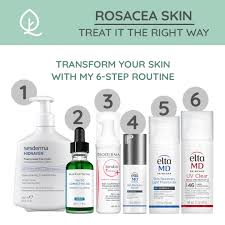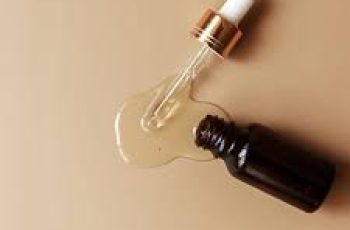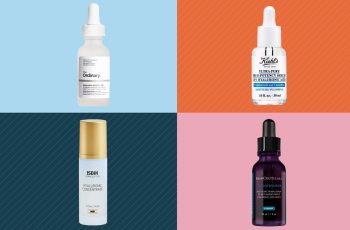
Best Rosacea Skin Care Routine
If you have rosacea, every product in your skin care routine should be carefully chosen to make sure the entire skin routine is rosacea-friendly. Rosacea-prone skin is super sensitive and can get a flare up if the wrong skin care products are used or if they are used in the wrong order in your regimen. Rosacea is not a skin type, but it is a skin concern found in 8 of the 16 Baumann Skin Types. Knowing which of these skin types you is crucial to build a anti-redness skin care regimen to calm your rosacea.
In this blog, I will be breaking down some of the most essential rosacea skin care routine tips that I’ve learned across my career as a dermatologist who also has rosacea.
Before we dive into the science of rosacea face care, make sure to take the Baumann Skin Type quiz so my advice will be more helpful to you. One you know which of the 16 skin types you are, you will be able to look for your skin type octagon next to products that are good for your redness-prone skin. If you have any questions about this blog, ask our skin care concierge AI bot and you may receive 20% off any purchases.
Dermatologist-Recommended Skin Care Routine for Rosacea
I have developed many rosacea skin care routines for my patients and have rosacea myself. Here are tips to figuring out what to use in a rosacea skincare regimen.
When you are building a rosacea routine, keep these tips in mind:
Know your Baumann Skin Type
Build your routine based on your Baumann Skin Type
Minimize exfoliation
Use soothing anti-inflammatory ingredients
Choose a calming moisturizer
Your cleanser must match your skin type
You may have more issues than just rosacea that your routine needs to treat such as oiliness, clogged pores, dryness, dark spots, and wrinkles. So you need a skin care routine designed to treat all of your barriers to skin health.
Keep reading to find different rosacea skin care routine options from top selling skin care brands.
Take the skin care routine quiz and we will help you build a custom rosacea routine choosing the best products from over 70 medical grade skin care brands.
Rosacea Skin Care Routine Steps and Order
The order that you apply skin care products matters because product influence the absorption, side effects, and efficacy of each other. This is the ideal order of skin care steps in a complete rosacea routine. You can substitute a prescription medications in step 3- the “rosacea cream” step.
Morning Rosacea Skin Care Routine
These are the steps for your morning rosacea routine:
Step 1: Soothing rosacea cleanser
Step 2 :Eye cream for sensitive skin
Step 3: Anti-redness serum/ cream or prescription medication
Step 4: Soothing moisturizer
Step 5: Nonchemical SPF
Night Rosacea Skin Care Routine
These are the steps for your evening rosacea routine:
Step 1: Soothing rosacea cleanser
Step 2 :Eye cream for sensitive skin
Step 3: Anti-redness serum or cream or prescription medication
Step 4: Soothing moisturizer
Step 5: Maybe a retinol if no flaring or stinging
When to use rosacea serums and creams with prescription rosacea medications in your skin care routine
Rosacea serums and creams are cosmeceutical products that are not FDA approved for rosacea but are often used by dermatologists to treat rosacea.
They may be used in conjunction with prescription rosacea medications.
If you combine your rosacea prescription medication with cosmeceutical anti-redness skin care products, this is when to use them in your skin care routine:
Apply the prescription medication after cleansing your face and applying eye cream.
Follow with a soothing occlusive moisturizer like Zerafite Soothing and Calming Moisturizer
Use the rosacea prescription medication in step 3 of your am and pm rosacea routine.
The Best Rosacea Skin Care Routines
Rosacea skin care routines have:
anti-redness ingredients that treat inflammation
no ingredients that sting the skin
no fragrance
no chemical sunscreens that irritate rosacea like avobenzone
no ingredients you are allergic to
The best rosacea routine is one tailored to your skin’s needs.
Do you have rosacea and dry skin- or do you have rosacea and oily skin?
Is your skin even-toned or does it have dark spots and rosacea?
Do you need anti aging products that are safe for rosacea?
Before we can give you a dermatologist-recommended rosacea skin care routine- we need to know more about your skin type.
I will give you example skin care routines from various medical grade skin care brands, but I prefer mixing and matching products from many brands and you need to take the quiz for that option.
Custom Skin Care Routines for Rosacea
People with rosacea need a custom dermatologist-recommended rosacea routine for a few reasons:
Washing the face irritates rosacea
Many products irritate the skin
Many products sting rosacea skin
Rosacea-affected skin needs more protection from the sun
Rosacea skin needs anti-inflammatory skin care
You want you products to be compatible with any rosacea prescription medications
There are many rosacea-friendly skin products, but the best rosacea routine is about finding a process you can follow daily to help your skin heal.
While everyone’s routine is different, your basic skin care routine for rosacea will include these steps every morning and night:
Apply a rosacea-safe rosacea cleanser that is right for your Baumann Skin Type® to your face with gentle circular motions, using your fingertips.
Thoroughly and gently rinse off the cleanser using your fingertips and lukewarm water.
Use a clean and dry cotton towel to gently pat your face dry.
Soothe your skin with moisturizer.
Apply a gentle eye cream to treat the redness and stinging rosacea can cause to the fragile eye area.
Apply a rosacea treatment -either a prescription cream or an over the counter anti-redness cream.
Cover with a soothing moisturizer that matches your skin type
In the am, apply a mineral chemical free sunscreen that is safe for rosacea on top of your moisturizer.
I put together a few rosacea routines from the top selling skin care brands. However, it is still best if you take our build a skin care routine quiz and design a custom routine by combining products from several different brands. Click the brand name below if you want advice on how to build a rosacea routine with products exclusively from that brand.
Skinceuticals
What should you not use on your face when you have a rosacea flare?
When you have rosacea, these are the skin care products to avoid when your skin is irritated:
Benzoyl peroxide
Chemical sunscreens like avobenzone
Hydroxyacids, AHAs
low pH ingredients
Vitamin C serums
Facial scrubs
Facial brushes
Strongly perfumed products
Don’t use exfoliants and acidic ingredients until your rosacea has calmed down. The only low pH ingredients that are OK to use when you are having a rosacea flare are:
azelaic acid
salicylic acid
Avoid other acids including ascorbic acid. Hyaluronic acid is ok to use because it is actually not very acidic and is not irritating.
Retinoids like retinoic acid should never be used during a rosacea flare. They can be used after 1-2 months of a soothing skin care routine if you are not experiencing any skin stinging.
Products to Use in a Rosacea Routine
Rosacea-safe Eye Creams
Rosacea blepharitis, a condition where rosacea affects the eyelids, requires careful selection of eye serums and creams to avoid exacerbating symptoms. Individuals with rosacea blepharitis should avoid eye serums and creams containing fragrances and irritating ingredients such as acids (e.g., glycolic, salicylic, and lactic acids). These components can trigger inflammation and worsen the irritation around the sensitive eye area. Instead, opt for gentle, fragrance-free formulations specifically designed for sensitive skin. Avoid retinol and AHA eye creams
Rosacea Safe Toners
Most toners should be avoided when you have rosacea because they have alcohol which can irritate the skin.
Toners should only be used in rosacea if you have oily skin and if they have soothing ingredients like:
Azelaic acid
Chamomile
Green tea
Fever few
Licorice extract
Use a toner before your rosacea medication, not after. This is our collection of rosacea safe toners:
Ingredients To Use In Your Rosacea Routine
Some ingredients like ascorbic acid and retinol can be used in rosacea, but have caveats to follow so they do not irritate your skin. In this section, I tell you how to properly use these in ingredients in your routine.
Hyaluronic Acid in Rosacea Routines
HA serums are OK to use when you have rosacea, however if they are good for your skin depends upon which of the 16 skin types you are. Benefits of HA in rosacea are:
Humectant ability gives temporary hydration
Can be kept in refrigerator and applied cold to soothe skin
Increase penetration of other ingredients
HA Serums are expensive and do not help rosacea- however they will not hurt rosacea-prone skin.
Vitamin C Serum in Rosacea Regimens
Many Vitamin C serums such as the Skinceuticals serums have a low pH of 2-2.5 to help l-ascorbic acid penetrate into the skin. This low pH will irritate rosace, cause facial flushing, and make the skin sting. So only use Vitamin C serums that are an ester from and formulated at a less irritating pH.
Here are some rosacea-safe Vitamin C serums like Jan Marini C-ESTA Face Serum that you can safely use in a rosacea skin care routine. If you have a rosacea medication in your am and pm regimen, don’t use a Vitamin C serum.
Vitamin C serums should be used at a different time of day than your topical rosacea medications.
Retinol and Rosacea
You should not use retinol when beginning a rosacea skin care routine. Once you have used a soothing skin care routine for 4- 8 weeks you can consider beginning a low strength retinol.
When you have rosacea, only use retinol if you don’t have:
Stinging
Scaling
Dryness
Uncomfortable skin
Painful skin
Retinol will be the last routine step in your night regimen after your rosacea cream and moisturizer at night.
Ingredients to Avoid
These ingredients can cause your skin to sting or flare, so avoid these in your skin routine:
Alcohol (denatured)
Benzyl alcohol
Benzoyl peroxide
Camphor
Capsaicin
Cinnamon oil
Clove oil
Eucalyptus oil
Fragrances
Ginger extract
Menthol
Mustard oil
Niacin (Vitamin B3)
Oregano oil
Peppermint oil
Witch hazel
These ingredients can cause irritation and exacerbate face flushing. These ingredients do not bother everyone with rosacea, so you may be able to tolerate these but be aware.
Phenoxyethanol is an ingredient in many ski care products that can cause problems if it is used in a high concentration. So look for products that have it farther down on the ingredient list which means there is a lower amount.
Rosacea Moisturizers
The best moisturizers you can use for rosacea depend upon if you are a dry or an oily skin type. Knowing your Baumann Skin Type can help you choose a rosacea moisturizer.
General tips for choosing a moisturizer for rosacea are:
Avoid hydroxyacid AHA creams
BHA salicylic acid creams are ok to use if you don’t have skin stinging.
Use creams or lotions with soothing ingredients
These are our favorite moisturizers for dry skin with rosacea:
Rosacea Sunscreens
In the mornings, you’ll want to add SPF to your routine to prevent sunburn. The best option is a physical or mineral SPF. Chemical sunscreens like octinoxate and avobenzone can irritate rosacea-prone skin or cause the eyes and face to sting. Zinc containing sunscreens with soothing ingredients are ideal. My favorite sheer mineral sunscreen with soothing ingredients for rosacea is Pavise Age Defense.
A tinted mineral sunscreen can help camouflage redness. The Rationale Beautiful Skin Sunscreen comes in 6 colors so the sunscreen will not look white and pasty on your skin. Here is our collection of rosacea friendly sunscreens:
Removing SPF When You Have Rosacea
It is not very easy to remove sunscreen when you have rosacea because you must be gentle and avoid harsh detergents. Avoid makeup removal wipes, bar soaps, and alcohol. Look for a gentle cream cleanser or an amino acid cleanser like Pavise Gentle Amino Powerwash which was designed to remove sunscreen.
Use very gentle circular motions to remove any trace of sunblock from your skin. Read this blog to learn more about how to remove sunscreen.
10 Tips to Reduce Rosacea Inflammation
The inflammation that rosacea causes can play a role in more serious diseases such as heart disease and diabetes. So tackling inflammation form all angles is important. Here are more ways to treat inflammation. You can also read my blog on treating rosacea from the inside to get more information on how to calm systemic inflammation.
Here are 10 holistic tips to reduce total body inflammation:
1. Get 7 + hours of sleep per night.
2. Meditate or do yoga or another relaxing activity once a day.
3. Add anti-inflammatory foods like salmon, argan oil and flaxseed oil to your diet.
4. Avoid your rosacea triggers which may be heat, alcohol, spicy food or hot beverages and food.
5. Use a body cream to reduce overall skin inflammation.
6. Avoid friction on the face when possible.
7. Avoid skin care with alcohol (fatty alcohols are OK)
8. Eat fruits and vegetables to normalize your microbiome.
9. Take probiotics.
10. Reduce sugar.
How long does it take a rosacea skin care routine to work?
Rosacea skin care usually works in about 8 weeks. These tip will help you get faster results:
Follow your custom routine every day
Be gentle on your skin when drying with towels, cleansing, or wiping off sweat.
Eat an anti-inflmmatory diet
Avoid rosacea triggers
If your rosacea is not improved at all in 8 weeks, see your dermatologist for a prescription rosacea medication or a rosacea treatment like the vascular laser or intense pulsed light. Find a doctor near you here.
Get started on the best skin care routine to get red of facial redness now! It can take weeks to work so stop wasting time and get started.


